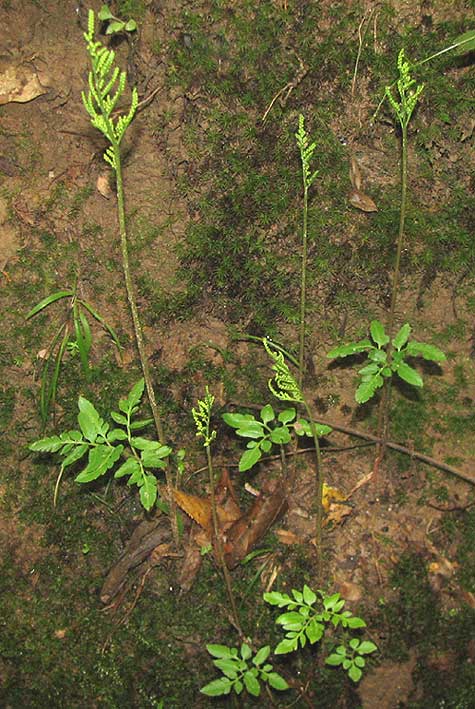Excerpts from Jim Conrad's
Naturalist Newsletter
from the August 26, 2012 Newsletter written at the woods edge in the Loess Hill Region a few miles east of Natchez, Mississippi, USA
DISSECTED GRAPEFERN
There's a primitive group of ferns with their spore producing part, instead of consisting of fruit-dots, or "sori," on the undersurfaces of their fronds like most ferns, group them in dense, grapelike clusters raised above the frond. It's the genus Botrychium, of which about 30 species are listed for North America. Most Botrychium species are called grapeferns because of their grapelike clusters of sporangia. The Botrychium species I usually run across, both in the US and Mexico, is the Rattlesnake Fern, Botrychium virginianum -- "rattlesnake" because those elevated clusters of sporangia are vaguely suggestive of a rattlesnake's tail stuck skyward. You can see this on our Rattlesnake Fern page is at https://www.backyardnature.net/n/x/rattle-f.htm.
Nowadays a less common, smaller species of Botrychium is emerging in this area, as shown in a flash-illuminated picture belowÑ

Those grapeferns are growing on a nearly vertical slope in the very shady, moist bottom of a deep, wooded ravine below my trailer. They're Dissected Grapeferns, BOTRYCHIUM DISSECTUM. Besides their fronds being smaller than the Rattlesnake Fern's, the stems of their clusters of sporangia, or sporophores, attach to the blade stalk near the ground, not at the very base of the frond blade, high above the ground, as in the Rattlesnake Fern.
Dissected Grapeferns occur throughout the eastern US and adjacent Canada, plus here and there in the Caribbean. The online Flora of North America says that it habitat ranges from open grassy areas to deep forest. Here I find it only in moist places with rich soil, such as right beside my trailer door, in deep shade, where this fern is emerging right now. Flora of North America also says that Dissected Grapeferns emerge in late spring, but ours are definitely coming online in late summer.